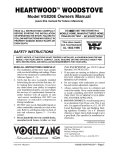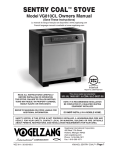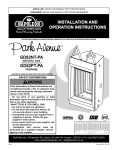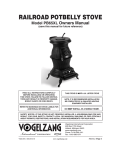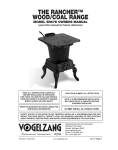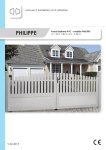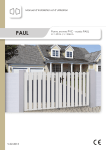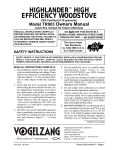Download Vogelzang International Sentry Coal VG810CL Specifications
Transcript
SENTRY COAL™ STOVE Model VG810CL Owners Manual (save this manual for future reference) READ ALL INSTRUCTIONS CAREFULLY BEFORE STARTING THE INSTALLATION OR OPERATING THE STOVE. FAILURE TO FOLLOW INSTRUCTIONS MAY RESULT IN PROPERTY DAMAGE, BODILY INJURY, OR EVEN DEATH. DO NOT USE THIS STOVE IN A MOBILE HOME, MANUFACTURED HOME, TRAILER OR TENT – NO EXCEPTIONS! This stove meets U.S. Test Standard: UL 1482-1996 SAFETY INSTRUCTIONS SAFETY NOTICE: IF THIS STOVE IS NOT PROPERLY INSTALLED, A HOUSE/BUILDING FIRE MAY RESULT. FOR YOUR SAFETY, CONTACT LOCAL BUILDING OR FIRE OFFICIALS ABOUT PERMITS, RESTRICTIONS, AND INSTALLATION REQUIREMENTS FOR YOUR AREA. READ ALL INSTRUCTIONS CAREFULLY. 1. The installation of this stove must comply with your local building code rulings. Please observe the clearances to combustibles (see reference figures 3–5). Do not place furniture or other objects within the clearance area. 2. Verify that the stove is properly installed before firing the stove for the first time. After reading these instructions, if you have any doubt about your ability to complete your installation properly, you must obtain the services of a professional licensed installer familiar with all aspects of safe and correct installation. DO NOT use temporary or makeshift compromises during installation. 3. DO NOT store coal, kindling, flammable liquids or other combustible materials too close to the unit. Refer to certification label on back of unit and reference figures 3 – 5 in this manual. 4. Do not install this stove in a mobile home, manufactured home, trailer or tent (NO EXCEPTIONS! per HUD Federal Standard: 24 CFR Ch.XX). 5. If any parts are missing or defective, please notify the dealer or manufacturer immediately. DO NOT OPERATE A STOVE THAT IS MISSING ANY PARTS!. 6. Do not tamper with combustion air control beyond normal adjustment capacities. 7. Always connect this stove to a chimney and vent to the outside. Never vent to another room or inside a building. DO NOT CONNECT THIS UNIT TO A CHIMNEY FLUE SERVING ANOTHER APPLIANCE. 8. DO NOT CONNECT a coal burning stove to an aluminum Type B gas vent. This is not safe. Use approved masonry or a UL 103 HT (U.S) Listed Residential Type and Building Heating Appliance Chimney. Use a 6” diameter chimney or larger, that is high enough to give a good draft. (See specifics in installation instructions). continued on next page Vogelzang International Corporation 400 West 17th Street Holland, Michigan 49423 www.vogelzang.com Phone: 1-616-396-1911 Fax: 1-616-396-1971 VGZ-011 / 090705.0 VG810CL SENTRY COAL™ / Page 1 SAFETY INSTRUCTIONS continued… 9. Be sure that your chimney is safely constructed and in good repair. Have the chimney inspected by the fire department or a qualified inspector. Your insurance company should be able to recommend a qualified inspector. 10. Creosote or soot may build up in the chimney connector and chimney and cause a house/ building fire. Inspect the chimney connector and chimney twice monthly during the heating season and clean if necessary. (See Chimney Maintenance, page 13). 11. In the event of a chimney fire, turn the air control to closed position, leave the building and CALL THE FIRE DEPARTMENT IMMEDIATELY! Have a clearly understood plan on how to handle a chimney fire by contacting your local fire authority for information on proper procedures in the event of a chimney fire. 12. To prevent injury, do not allow anyone to use this stove who is unfamiliar with the correct operation of the stove. 13. Do not operate stove while under the influence of drugs or alcohol. 14. Ashes should not be allowed to accumulate higher than the ash pan. Dispose of ashes in a metal container with a tight fitting lid. Keep the closed container on a noncombustible floor or on the ground, well away from all combustible materials. Keep the ashes in the closed container until all cinders have thoroughly cooled. The ashes may be buried in the ground or picked up by a refuse collector. 15. The special paints used on your stove may give off some smoke and an odor while they are curing during the first 12 to 15 fires. Additional smoke and odor may be emitted from the light oils used in construction of the fire box. This should disappear after a short period of time and not occur again. Persons with lung conditions or owners of susceptible domestic pets (such as birds) should take prudent precautions. Open windows and doors as needed to clear smoke and/or odor. Paint discoloration will occur if the stove is overfired. 16. This stove has a painted surface which is durable but it will not stand rough handling or abuse. When installing your stove, use care in handling. Clean with soap and warm water when stove is NOT hot. Do not use any acids or scouring soap, as these wear and dull the finish. Page 2 / VG810CL SENTRY COAL™ 17. The walls of the firebox may become slightly distorted after a period of use. A slight distortion will not affect the operation of the stove. 18. While stove is in operation, all persons, especially young children should be alerted to the hazards from high surface temperatures. Keep away from a hot stove to avoid burns or clothing ignition. 19. If small children will be in the same room as the stove during operation, provide a sturdy barrier to keep them at a save distance from the stove. NEVER LEAVE SMALL CHILDREN UNSUPERVISED when they are in the same room as the stove. 20. Keep stove area clear and free from all combustible materials, gasoline, and other flammable vapors and liquids. 21. To prevent burns always wear protective clothing, leather hearth gloves and eye protection, while tending the fire. 22. While in operation, keep the feed door, ash door, and cabinet door closed at all times except while tending the fire. 23. Do not overfire the stove. Overfiring will happen if the feed door or ash door is left open during operation. Such actions can result in very dangerous operating conditions. 24. All power cords and electrical appliances and/or assemblies must be kept outside of the clearance dimensions shown in this manual for combustible materials. 25. For further information on using your stove safely, obtain a copy of the National Fire Protection Association (NFPA) publication, “Using Coal and Wood Stoves Safely” NFPA No. HS-10-1978. The address of the NFPA is Batterymarch Park, Quincy, MA 02269. NOTE: A PROFESSIONAL, LICENSED HEATING AND COOLING CONTRACTOR MUST BE CONSULTED IF YOU HAVE QUESTIONS REGARDING THE INSTALLATION OF THIS SOLID FUEL BURNING APPLIANCE. VGZ-011 / 090705.0 ASSEMBLY INSTRUCTIONS NOTICE: Vogelzang International Corp. grants no warranty, stated or implied, for the installation or maintenance of your wood stove and assumes no responsibility of any incidental or consequential damages. TOOLS AND MATERIALS REQUIRED FOR INSTALLATION TOOLS MATERIALS Pencil 6 foot Folding Rule or Tape Measure Tin Snips Drill: Hand or Electric 1/8” dia. Drill Bit (sheet metal screws) 1/4” dia. Drill Bit (damper installation) Screwdrivers (phillips and blade type) 6mm Nut Driver or Ratchet with 6mm Socket Safety Glasses (NOTE: The following items are NOT included with your stove) Chimney Connection: 6” black steel (24 ga. min.) straight stove pipe or elbow (as required) 1/2” Sheet Metal Screws Chimney: Existing 6” Lined Masonry Chimney or 6” Inside Dia. listed Type HT chimney. Flooring Protection: 42” x 60” as specified (see figures 3–5) Furnace Cement (manufacturer recommends Rutland Code 78 or equivalent) Gloves reaching under the cabinet frame 1. Uncrate the stove and remove cardboard packing and protective poly bag. (Save cardboard and pulling the door open. for further assembly.) 9. Install the door knob onto the outside 2. Remove legs, upper and lower heat shields, of the door. Install the machine damper, and hardware pack from inside firescrew through the latch bracket, box. door, and into the knob. 3. Place flattened carton behind stove and careTighten securely. fully turn stove onto its back. (fig. 2). Fig. 2 Cabinet 4. Join the upper and lower heat shields with four Door Knob Assembly (4) self-tapping screws (fig. 1). Upper Heat Shield Fig.1 Leg & Heat Shield Assembly Leg Assembly Lower Heat Shield WARNING: METAL PANELS FASTENED BETWEEN LEGS ACT AS HEAT DEFLECTORS. THESE PANELS MUST BE IN PLACE FOR SAFE OPERATION. 5. Place both legs upside down and attach the heat shield assembly (from step 4) between the legs. Align the holes in the heat shield assembly with those in the mounting flange of the leg assemblies and secure with four (4) self-tapping screws. 6. Attach leg/heat shield assembly to the base of the stove using self-tapping screws provided (fig. 1). 7. Carefully lift stove to upright position. 8. Locate the door knob and machine screw in the hardware pack. Open the cabinet door by VGZ-011 / 090705.0 VG810CL SENTRY COAL™ / Page 3 LOCATING STOVE 1. The stove must be placed on solid concrete, with three (3) sheet metal screws in each stove solid masonry, or when installed on a combuspipe and/or elbow joint to firmly hold the pipe tible floor, on a listed floor protector, use a sections together. DO NOT CONNECT THIS minimum 3/8” noncombustible floor protecSTOVE TO ANY AIR DISTRIBUTION OR tor with an “R” factor of 0.8 such as Hy-C or DUCT SYSTEM. Imperial Model UL 4260BK or equivalent. 5. Recheck clearances from the stove, (NOTE: To calculate R-values of equivalent connector stove pipe, and corner clearances alternative materials, see page 16). The base using the illustrations in figures 3 – 5 and must extend at least 16” beyond the side with your local building codes or fire protection the access door, 8” to the sides of fuel openordinances. ing, and must extend under the stove pipe if it NOTE: A wall faced with drywall, brick or is elbowed towards a wall. (See figures 3 & 4 stone must be considered a combustible and consult local building codes and fire prosurface. tection ordinances.) 6. DO NOT INSTALL THIS STOVE IN A MOBILE CAUTION: (FIRE HAZARD) CARPETING AND HOME,TRAILER OR TENT – NO EXCEPTIONS! OTHER COMBUSTIBLE MATERIAL MUST NOT (HUD Federal Standard: 24 CFR Ch.XX) COVER THE FLOOR PROTECTOR. THESE 7. The clearances provided are minimum dimenMATERIALS MUST REMAIN OUTSIDE OF sions determined by the manufacturer’s testCOMBUSTIBLE CLEARANCES, SEE FIG. 3-5. ing facility. Installation of this stove must 2. The stove must have its own flue. DO NOT comply with the latest edition of NFPA 211 for CONNECT THIS UNIT TO A CHIMNEY reduced clearances and/or your local building FLUE SERVING OTHER APPLIANCES. code rulings (use whichever minimum dimen3. After observing the clearances to combustible sions are LARGEST). materials (figures 4 & 5), locate your floor Failure to follow these minimum clearance protector accordingly (figure 3) and carefully requirements may result in an unsafe instalplace the stove in your selected location. lation and could cause a fire. Install stove pipe, elbows, and thimble as 8. This stove meets U.S. Test Standard: required, utilizing either a recently cleaned and UL 1482-1996. inspected 6” masonry chimney or a 6” i.d. CAUTION: KEEP FURNISHINGS AND OTHER listed chimney. COMBUSTIBLE MATERIALS AWAY FROM THE 4. Use 6” round black stove pipe, not STOVE. galvanized stove pipe. Secure pipe sections Continued on next page TOP VIEW NON COMBUSTIBLE CONSTRUCTION IN ACCORDANCE WITH NFPA 211 18" 28" BACKWALL 60" DASHED LINE SHOWS STRAIGHT OUT CHIMNEY CONNECTOR AND ADDITIONAL FLOOR PROTECTOR REQUIRED 15" 42" 19" SIDEWALL FLOOR PROTECTOR 14" 32" 16" 8" Fig. 3 – TOP VIEW Minimum Clearance Dimensions from Combustible Surfaces Page 4 / VG810CL SENTRY COAL™ VGZ-011 / 090705.0 LOCATING STOVE continued… CORNER CLEARANCES 18" 18" Fig. 4 – Top View Minimum Corner Clearances from Combustible Surfaces NOTE: BEFORE FIRING STOVE SLIDE FIREBRICKS TOWARDS THE REAR SO NO GAPS REMAIN BETWEEN BRICKS. 20" 16" 18" 14" 28" 15" FLOOR PROTECTOR Fig. 5a – Front View Minimum Clearance Dimensions from Combustible Surfaces BACKWALL SIDEWALL 18" FLOOR PROTECTOR Fig. 5b – Side View Minimum Clearance Dimensions from Combustible Surfaces D-6 DRAFT DAMPER A Draft Damper included with the stove must be installed in the first straight section of pipe exiting the stove before the stove pipe is connected and the coal stove is used. 1. Drill two 1/4” holes centered on either side of the pipe section 6” from the top end of the pipe (figure 6). 2. Remove the handle from the damper then slide the damper into the pipe. 3. Align the damper with the holes drilled in step 1 and insert the handle through the holes and the damper. NOTE: This damper is necessary for the proper operation of the stove and to meet EPA emissions requirements for heating appliances. It MUST be installed before use.(NO EXCEPTIONS) VGZ-011 / 090705.0 DRAFT DAMPER (must be installed before use — NO EXCEPTIONS) 6"/15.25 cm Fig. 6 – Draft Damper Installation VG810CL SENTRY COAL™ / Page 5 CONNECTOR PIPE INSTALLATION smoke spillage. Where possible, use only 1. The crimped end of the stovepipe fits inside corrugated (nonadjustable) elbows. These the stove flue collar. Install additional pipe and are much more airtight. elbow with the crimped end towards the stove. This will allow any condensation in the flue to 7. The connector pipe must not pass through an run back into the firebox. attic or roof space, closet, or any concealed space, or floor, ceiling, wall or combustible 2. Horizontal pipe runs must slope upwards construction.(See Chimney Connector Systems towards the chimney at least 1/4” per foot of & Clearances, page 17). A UL 103 HT Listed horizontal run. chimney must be used from the first penetra3. You must have at least 18 inches of clearance tion of ceiling or wall to the chimney cap. between any horizontal piping and the ceiling. Never use single wall connector pipe as 4. The pipe cannot extend into the chimney flue a chimney – a house fire could result! (figure 7). 5. Secure pipe/elbow sections with three (3) sheet NOTE: STOVE PIPE IS NOT INCLUDED. TO metal screws at each joint to make the piping PURCHASE, VISIT YOUR LOCAL HARDWARE, rigid. HOME OR BUILDING CENTER. SEE “LOCATING STOVE” PAGE 3 FOR ADDITIONAL 6. It is recommended that no more than two (2) SPECIFICATIONS. 90° bends be used in the stovepipe installation. The use of more than two 90° bends may decrease the amount of draw and possibly cause CORRECT WRONG WRONG Fig. 7 – Stovepipe/Flue Connections Page 6 / VG810CL SENTRY COAL™ VGZ-011 / 090705.0 CHIMNEY CONNECTIONS The stove must be connected to either a masonry or manufactured metal chimney built and tested to the specifications listed on the previous pages. Chimneys perform two functions: 1). As a means of exhausting smoke and flue gases which are the result of fuel combustion. 2). The chimney provides “draft” which allows oxygen to be continuously introduced into the appliance, so that proper combustion is possible. This stove relies on natural draft to operate. NOTICE: Always provide a source of fresh air into the room where the stove is located. Failure to do so may result in air starvation of other fuel burning appliances and the possible development of hazardous conditions, fire or death. Your stove itself does not create draft. Draft is provided by the chimney. To achieve proper draft your chimney must meet the three minimum height requirements detailed in figures 9–11. A minimum of 0.05 w.c. (measured in water column) is required for proper drafting to prevent back puffing, smoke spillage, and to maximize performance. (Gauges to measure draft are readily available at stove stores and are economical to rent or purchase.) Factors such as wind, barometric pressure, trees, terrain and chimney temperature can have an adverse effect on the draft. The manufacturer cannot be held responsible for external factors leading to less than optimal drafting. Should you have a problem with inadequate draft, you should contact a licensed heating and cooling contractor for assistance in solving the problem. IMPORTANT Installation Points 1. Size chimney flue to stove collar. This stove requires a 6” diameter flue. 2. Never connect this unit to a chimney serving another appliance. 3. The chimney must meet all minimum height requirements. 4. Never use a chimney to ventilate a cellar or basement. 5. Contact your local building authority for approved methods of installation and any necessary permits and/or inspections. MASONRY CHIMNEY Before using an existing masonry chimney, clean the chimney, inspect the flue liner and make any repairs needed to be sure it is safe to use. Make repairs before attaching the stove. The connector stove pipe and fittings you will need to connect directly to a masonry chimney are shown in figure 8. CHIMNEY THIMBLE COLLAR 6˝ ROUND 24 ga. BLACK CONNECTOR STOVEPIPE FLUE 5/8" TILE CHIMNEY LINER 8˝ MIN. LINER BELOW ENTRY HOLE MASONRY CHIMNEY Fig. 8 - Masonry Chimney Connection If the connector stove pipe must go through a combustible wall before entering the masonry chimney, consult a qualified mason or chimney dealer. The installation must conform to local building and fire codes and latest edition of NFPA 211. If there is a cleanout opening in the base of the chimney, close it tightly. Fig. 9 - Chimney Construction Through Attic Space VGZ-011 / 090705.0 VG810CL SENTRY COAL™ / Page 7 CHIMNEY CONNECTIONS continued … Fig. 10 - Chimney Construction Through Roof Fig. 11 - Chimney Connection to Firebox Through Masonry Wall MANUFACTURED CHIMNEY REFER TO CHIMNEY AND CHIMNEY CONNECTOR MAKER’S INSTRUCTIONS FOR INSTALLATION AND USE. Use only 6” diameter listed chimney UL 103 HT. Chimney made to this listing is High Temperature rated to 2100 degrees Fahrenheit. Use chimney from only one manufacturer. Never mix brands. Carefully follow the chimney manufacturer’s stated requirements and clearances. Use the chimney manufacturer’s attic guards, roof supports, flashing and fire stops when passing through a ceiling. Use a listed thimble when passing through a combustible wall. Do not use makeshift compromises during installation. Never use a single-wall connection pipe as a chimney! When using a pre-existing chimney, have it’s condition and installation inspected before using. Make sure that the chimney meets all of the UL rating requirements listed above. Be aware that not all manufactured chimney is of the UL 103 HT type. NOTE: It is recommended that you contact a licensed heating and cooling contractor (consult your local yellow pages) for chimney installation. Manufactured chimney with the proper required UL listing is available from most home centers, hardware stores, and HVAC supply stores. If you have access to the internet, you may wish to view chimney manufacturers’ information on-line. See, www.duravent.com, www.selkirkinc.com, or www.mtlfab.com. VENTING TO EXISTING FIREPLACE In some instances, people desire to convert an existing fireplace for stove use. Usually, safe connection to an existing masonry chimney requires more work than using a prefabricated chimney. The existing fireplace must be closed and sealed at the damper with high-temperature caulk, ceramic wool, or furnace cement. Prior to installation, clean and inspect the existing flue and smoke shelf. Installation should be designed so the system can be dismantled for periodic cleaning and inspection. Before conversion, make sure the existing chimney is structurally sound, the chimney incorporates Continued on next page Page 8 / VG810CL SENTRY COAL™ VGZ-011 / 090705.0 CHIMNEY CONNECTIONS continued … a flue liner and make sure it is in good condition. (A flue liner consists of clay tile that protects the brickwork of a chimney. If a chimney does not have a liner, or it is damaged, have it relined by a professional. DO NOT USE a chimney that is unlined or damaged!) If you have any question regarding the condition of the chimney, consult a qualified licensed contractor, qualified engineer, competent mason, certified Chimney Sweep, or a knowledgable inspector. Consult your insurance company if you cannot find a qualified expert. CAUTION: NOT ALL FIREPLACES ARE SUITABLE FOR CONVERSION TO A WOOD STOVE. CHECK WITH A QUALIFIED EXPERT. Many prefabricated fireplaces are of the “zeroclearance fireplace” category. These consist of multilayered metal construction. They are designed with enough insulation and/or air cooling on the base, back and sides so they can be safely installed in direct contact with combustible floors and walls. Although many prefabricated fireplaces carry endorsements from nationally recognized organizations for use as fireplaces, they have not been tested for connection to wood stove heaters. Connecting a stove to such a device will void the manufacturer’s warranty. Steel-lined fireplaces are constructed with 1/4” firebox liner, an air chamber in connection with 8” of masonry. These can be safely used with wood burning stoves. They contain all the essential components of a fireplace, firebox, damper, throat, smoke shelf, and smoke chamber. Many look identical to masonry fireplaces and should be checked carefully before connecting a stove to them. Venting a stove directly into a fireplace does not meet code and should not be attempted. (This constitutes connection to another appliance - the fireplace.) Combustion products will be deposited and build up in the firebox or fireplace. The stove warranty will be void with such an installation. Do not create a hazard in your home by connecting in this manner. VGZ-011 / 090705.0 FIREPLACE INSTALLATION Directly connecting the stovepipe into the existing masonry chimney (figure 12 “Type A” fireplace conversion) of the fireplace is the only approved method of installation. This is a complicated and involved process and to insure safety should only by done by a qualified installer. 1. An entry hole must be cut through the masonry and tile liner with minimal damage to the liner. At least 8” of liner must remain below the entry position. When locating the stove and stovepipe, all minimum clearances must be observed from combustible surfaces including mantels, combustible trimwork, ceilings and walls. Positioning the center of the stove pipe entry into the chimney 24” below the ceiling should insure proper clearance for a 6” stovepipe. 2. Install a metal or fire clay (5/8” minimum thickness) thimble. Make sure the thimble is flush with the inner surface of the chimney liner and does not protrude into the flue (see figure 7 on page 6). 3. Secure the thimble with refractory mortar. The thimble should be surrounded by 8” of solid unit masonry brickwork or 24” of stone. 4. Install the stovepipe into the thimble as far as possible without extending past the flue lining (see figures 7 & 8 on pages 6 & 7). 5. A small airspace (about 1/2”) should remain between the stovepipe and thimble to allow for expansion of the pipe. Seal this airspace with high-temperature caulking or ceramic wool. Continued on next page FIG. 12 - Fireplace Conversion VG810CL SENTRY COAL™ / Page 9 CHIMNEY CONNECTIONS continued … 6. Secure and seal the damper in the closed position using high-temp caulking, ceramic wool, or furnace cement. Also check to see if the chimney has a cleanout. If it does, make sure it is closed and sealed as well. A leaky cleanout will greatly reduce draft efficiency. If you have any questions regarding venting your stove, contact the manufacturer or contact the National Fire Protection Association (NFPA) and request a copy of the latest editions of NFPA Standard 211 and NFPA Standard 908. Their address is: Battery March Park, Quincy, MA 02269. OPERATING INSTRUCTIONS CAUTION: HOUSE FIRE HAZARDS • GASES EMITTED FROM FRESHLY ADDED COAL MUST BE BURNED OR THEY WILL ACCUMULATE AND EXPLODE. NEVER SMOTHER A FIRE WHEN ADDING FRESH COAL. • NEVER USE MANUFACTURED COAL “BRICKS” MADE OF COAL DUST AND WAXTYPE BINDER. • OVERFIRING MAY CAUSE A HOUSE FIRE. IF A UNIT OR CHIMNEY CONNECTOR GLOWS, YOU ARE OVERFIRING. • BUILD FIRES ONLY ON INTEGRAL GRATE INCLUDED WITH THE STOVE. • DO NOT OPERATE THE HEATER WITH THE MINIMUM FIRE AIR SHUTTER COMPLETELY CLOSED. OPERATING SAFETY PRECAUTIONS 1. NEVER OVERFIRE THIS STOVE BY BUILDING EXCESSIVELY HOT FIRES AS A HOUSE/ BUILDING FIRE MAY RESULT. IF STOVE OR STOVEPIPE BEGINS TO GLOW OR TURN RED, YOU ARE OVERFIRING THE STOVE. 2. NEVER BUILD EXTREMELY LARGE FIRES IN THIS TYPE OF STOVE AS DAMAGE TO THE STOVE OR SMOKE LEAKAGE MAY RESULT. 3. HOT WHILE IN OPERATION. KEEP CHILDREN, CLOTHING, AND FURNITURE AWAY. CONTACT MAY CAUSE SKIN BURNS. DO NOT TOUCH THE STOVE AFTER FIRING UNTIL IT HAS COOLED. 4. PROVIDE AIR INTO THE ROOM FOR PROPER COMBUSTION. 5. INSPECT STOVEPIPE EVERY 90 DAYS. REPLACE IMMEDIATELY IF STOVEPIPE IS RUSTING OR LEAKING SMOKE INTO THE ROOM. WARNING: EXPLOSION HAZARD • NEVER USE CHEMICALS, GASOLINE, GASOLINE-TYPE LANTERN FUEL, KEROSENE, CHARCOAL LIGHTER FLUID, OR SIMILAR FLAMMABLE LIQUIDS TO START OR “FRESHEN-UP” A FIRE IN THE STOVE. • KEEP ALL FLAMMABLE LIQUIDS, ESPECIALLY GASOLINE, OUT OF THE VICINITY OF THE HEATER — WHETHER IN USE OR IN STORAGE. • THE USE OF WOOD IN THIS STOVE EXCEPT FOR INITIAL COAL IGNITION PURPOSES, IS A VIOLATION OF FEDERAL LAW. THIS STOVE IS DESIGNED TO BURN COAL FUEL. Chestnut, egg, stove, or nut-size coal for residential furnaces, or any of the specialty packaged fireplace coals (not wax-type coal “bricks”) can be used. Low ash content (2% to 6%) coal is recommended. NOTICE: FOR BEST RESULTS USE SOLID, BITUMINOUS COAL. NEVER USE MANUFACTURED COAL “BRICKS” MADE OF COAL DUST WITH WAX-TYPE BINDER. DO NOT BURN GARBAGE OR FLAMMABLE FLUIDS. STORE COAL IN DRY WELL VENTILATED AREA. SEE RECOMMENDATIONS ON PAGE 12 FOR USING ANTHRACITE COAL. LIGHTING 1. Set the thermostat on “HIGH” and open pipe draft damper to provide maximum draft. 2. Using the separable handle, open the feed door and place paper and kindling wood on the grate for starting the fire. 3. Light fire, close and secure the feed door. Continued on next page Page 10 / VG810CL SENTRY COAL™ VGZ-011 / 090705.0 OPERATING INSTRUCTIONS continued … 4. Add about 15 pounds of coal after fire is burn– Stir the coal and watch the fire. Be sure the ing briskly. Use care not to smother the new coal is burning before you close the doors kindling fire when adding coal. and turn the thermostat down. 5. Set the thermostat to maintain desired tempera- 3. At least once every 12 hours of operation crank ture. “MEDIUM” setting is normally the roller grate system to dump ‘clinkers’ and satisfactory. Set higher or lower for your ash into the ash pan. personal comfort level. 4. Empty ash pan regularly. Do not allow ashes to pile up to the grate. If ashes build up to the grate, it can warp and burnout will occur. ADDING FUEL If allowed to overfill, ashes may spill when When starting fires, add small amounts of coal removing the pan. each hour or so instead of piling large quantities of coal every 3 to 5 hours. As you become more 5. Properly dispose of hot ashes (see Safety Instructions, item #14 on page 2). familiar with the operation of your stove, it is possible to add coal to burn for longer periods of time (between 8 to 10 hours), but doing so MINIMUM FIRE The rate of burning at the “LOW” thermostat carelessly will promote incomplete combustion and considerable sooting, along with a very dirty, setting can be further controlled by adjusting the draft damper door located behind the cabinet on inefficient fire. 1. Set thermostat to “HIGH” and open pipe draft the front of the firebox (figure 14). 1. Partially close the shutter to make the fuel burn damper before opening the feed door. longer. 2. Never smother the fire when adding coal. 2. Open the shutter, exposing a larger opening, to Incomplete combustion of fresh coal will cause reduce the formation of soot (see notes on gas accumulation and a mild smoky explosion Chimney Draft, page 12.) will occur: – Add fresh kindling if the bed of coals has 3. Do Not operate the heater with the minimum fire shutter completely closed (see below). cooled. - Add up to 20 lbs. of coal. Never add coal above the top of the firebrick. MINIMUM FIRE AIR SHUTTER The thermostat control was calibrated at the factory and is not adjustable. The operation of the heater may require a change in calibration of the minimum fire air shutter. Calibration adjustments should be made at room temperature. The minimum fire air shutter is mounted on the door of the thermostat draft damper mounted behind the front screen on the lower front of the firebox, fig 14. After stove has cooled the cabinet lid may be opened to make adjustments. A. CAUTION: DO NOT OPEN OR CLOSE TOP WHEN HEATER IS HOT! 1. To open, grasp the cabinet top at front (figure 13A) and lift all the way up. 2. Gently lower the top until the top support rod latches to hold the top in the up position (figure 13B). 3. To close, lift the top until the support rod is unlatched. 4. Pull the support rod forward as you lower the cabinet top. VGZ-011 / 090705.0 Fig. 13 Thermostat Adjustment Access VG810CL SENTRY COAL™ / Page 11 OPERATING INSTRUCTIONS continued … B. Adjusting the Minimum Air Shutter: The minimum air shutter has an infinite number of settings. Several adjustments may be necessary for the unit to work most effectively for your particular installation. 1. The minimum air shutter may be adjusted to the closed position in installations where the draft is “above normal.” Generally, 0.06 w.c. or above would be considered “above normal.” 2. In installations where the draft is “below normal”, the minimum air shutter would be adjusted toward the open position. RECOMMENDATIONS FOR BURNING ANTHRACITE COAL 1. When burning coal, it is important to maintain a clean chimney. Inspect chimney connector and chimney at least twice monthly during the heating season. 2. Keep the grate clear of ash and cinders. Use the shaker grate to keep the ashes from building up in the firebox. 3. DO NOT operate the stove with the ash door, feed door, or cabinet door open. 4. Before adding coal, it is necessary to have a good hot log fire burning. After the log fire is burning, add small amounts of coal until a bed of coals has been built up. Anthracite coal burns with a short, blue flame with the coals having a glowing, red color. 5. Anthracite coal needs a strong draft to burn efficiently. A draft reading of 0.05 to 0.06 w.c. (water column) is required to burn anthracite. Fig. 15 Feed Door Draft Wheel Adjustment Fig. 14 Minimum Shutter Adjustment NOTE: MORE THAN ONE RECALIBRATION MAY BE NECESSARY. AT ROOM TEMPERATURE (72 ° F) AND “LOW” SETTING, THE DRAFT DAMPER DOOR SHOULD BE CLOSED. The draft wheel located on the feed door, figure 15, provides a source of secondary air and should be opened when burning coal. Coal emits volatile gases when burned and requires a source of secondary air for complete combustion to occur. The draft wheel may be adjusted to give the best performance depending on the particular needs of the user. CHIMNEY DRAFT Do not expect the stove to draw. Draft is a function of the chimney, not the stove. Smoke spillage into the house or excessive buildup of condensation or soot in the chimney are warnings that the chimney is NOT functioning properly. Correct the problem before using the stove. Following are some possible causes for improper draft. 1. The connector stovepipe may be pushed into the chimney too far, stopping the draft. 2. If the chimney is operating too cool, water will condense in the chimney and run back into the stove. Soot formation will be rapid and may block the chimney. Operate the stove at a high enough fire level to keep the chimney warm preventing this condensation. 3. If the fire burns well but sometimes smokes or burns slowly, it may be caused by the chimney top being lower than another part of the house or a nearby tree. The wind blowing over a house or tree, Continued on next page Page 12 / VG810CL SENTRY COAL™ VGZ-011 / 090705.0 falls on top of the chimney like water over a dam, beating down the smoke. The top of the chimney should be at least three (3) feet above the roof and be at least two (2) feet higher than any point of the roof within ten (10) feet. NOTE: A DRAFT READING OF 0.05 TO 0.06 W.C. (WATER COLUMN) IS SUGGESTED FOR PROPER BURNING OF THIS STOVE. CHIMNEY MAINTENANCE CREOSOTE – Formation and Removal When coal is burned slowly, it produces tar and other organic vapors which combine with expelled moisture to form creosote. The creosote vapors condense in the relatively cool chimney flue of a slow-burning fire. As a result, creosote residue accumulates on the flue lining. If ignited, this creosote creates an extremely hot fire which may ignite surrounding materials resulting in a building fire. The chimney connector and chimney should be inspected at least twice a month during the heating season to determine if a creosote buildup has occurred. If creosote has accumulated, it should be removed. Failure to remove creosote may result in ignition and may cause a house/building fire. Creosote may be removed using a chimney brush or VGZ-011 / 090705.0 other commonly available materials from your local hardware retailer. Chimney fires burn very hot. If the chimney connector should glow red, immediately call the fire department, then reduce the fire by closing the inlet air control and pour a large quantity of coarse salt, baking soda, or cool ashes on top of the fire in the firebox. CAUTION: A CHIMNEY FIRE MAY CAUSE IGNITION OF WALL STUDS OR RAFTERS WHICH WERE ASSUMED TO BE A SAFE DISTANCE FROM THE CHIMNEY. IF A CHIMNEY FIRE HAS OCCURRED, HAVE YOUR CHIMNEY INSPECTED BY A QUALIFIED PERSON BEFORE USING AGAIN. VG810CL SENTRY COAL™ / Page 13 PART ORDERING – VG810CL SENTRY COAL™ STOVE When ordering missing or replacement parts, always give the Model Number of the stove, Part Number, and Part Description. Use the illustrations and part lists provided on the following pages to identify parts. Part No. 1 2 3 4 5 6 7 8 9 10 11 Description Qty. Cabinet Top .............................................. 1 Cabinet, Back ........................................... 1 Cabinet, Left Side ..................................... 1 Cabinet, Front Asm. .................................. 1 Cabinet, Door Frame ................................ 1 Cabinet, Door ........................................... 1 Knob, Cabinet Door .................................. 1 Screw, 8-32x1/4” Mach. ............................ 1 Latch, Spring ............................................ 1 Nut, 10-24 ................................................. 8 Screw, 10-24x1/2” Flat Head. ................... 8 Page 14 / VG810CL SENTRY COAL™ Part No. 12 13 14 15 16 17 18 19 20 21 Description Qty. Hinge, Door .............................................. 4 Back Brace ............................................... 2 Thermostat Assembly ............................... 1 Chain Linkage, Thermostat ...................... 1 Top Shield, Thermostat ............................. 1 Screw, 10-16x3/4” Torx ............................. 2 Knob, Thermostat ..................................... 1 Support, Hinge ......................................... 1 Clip, Hinge ................................................ 1 VGZ-011 / 090705.0 PART ORDERING – VG810CL SENTRY COAL™ STOVE When ordering missing or replacement parts, always give the Model Number of the stove, Part Number, and Part Description. Use the illustrations and part lists provided on the following pages to identify parts. Part No. 22 23 24 25 26 27 28 29 30 31 32 33 34 35 36 37 38 39 40 41 42 43 44 Description Qty. Firebox Asm .............................................. 1 Firebrick ................................................... 10 Liner, Front & Rear ................................... 3 Leg ............................................................ 2 Heat Shield, Upper ................................... 1 Heat Shield, Lower ................................... 1 Draft Control ............................................. 1 Clip, Spring ............................................... 1 Frame, Draft Damper ................................ 1 Pin, Draft Damper ..................................... 1 Support, Grate & Liner ............................. 2 Retainer, Top Brick ................................... 2 Shield, Front ............................................. 1 No.10x1/2” Torque H.D. ............................ 2 Ash Pan Assembly ................................... 1 Damper Asm. ............................................ 1 Smoke Curtain .......................................... 1 Bracket, Smoke Curtain ........................... 1 Screw, 1/4-20x3/4” Flat Head ................... 1 Nut, 1/4-20 ................................................ 1 Door, Ash .................................................. 1 Steel Liner ................................................ 1 VGZ-011 / 090705.0 Part No. 45 46 47 48 49 50 51 52 53 54 55 56 57 58 59 60 61 62 63 64 65 66 67 Description Qty. Gasket, 29” Ash Door ............................... 1 Door Asm., Feed ...................................... 1 Handle, Separable (Spring) ...................... 1 Handle, Door ............................................ 1 Latch, Door ............................................... 1 Spacer, ..................................................... 1 Screw, 1/4-20x3/4” Mach .......................... 1 Nut, 1/4-20 ................................................ 1 Gasket, 45” Feed Door ............................. 1 Pin, Door Hinge ........................................ 4 Liner, Top .................................................. 1 Nut, 1/4-20 ................................................ 6 Screw, 1/4-20x3/4” Flat Head. .................. 6 Flue Collar ................................................ 1 Gasket ...................................................... 1 Fire Grate Extension ................................ 1 Frame, Shaker Grate ................................ 1 Retainer, Shaker Grate Cog ..................... 1 Handle, Shaker Grate ............................... 1 Cog, Right Hand, Shaker Grate .............. 1 Cog, Left Hand, Shaker Grate ................. 1 Grate, Right Hand .................................... 1 Grate, Left Hand ....................................... 1 VG810CL SENTRY COAL™ / Page 15 FLOOR PROTECTOR MATERIAL CALCULATIONS This stove has been tested for and must be installed on a floor protector with the proper Thermal Resistance or R-value as stated in the installation instructions on page 3, “Locating Stove” step 1, of this manual. If the floor protector materials listed in the instructions are not available, materials with an equivalent R-value may be substituted. Alternate materials may be rated with C-factor (Thermal Conductance) or k-factor (Thermal Conductivity) ratings which must be converted to R-value to determine if the alternate material meets the tested requirements. The following instructions provide the proper information and formulas for conversion to R-value. To determine if alternate materials are acceptable follow this sequence. 1. Convert material specifications to R-value: a. R-value given — no conversion necessary b. k-factor is given with a required thickness (T) in inches: R = 1/k x T c. C-factor is given: R = 1/C 2. Determine the R-value of proposed alternate floor protector: a. Use formulas in step 1 above to calculate R-value of proposed material(s). b. For multiple layers, add R-values of each layer to determine overall R-value. 3. If the overall R-value of the floor protector system is equal to or greater than the floor protector specifications given, the alternate is acceptable. Definitions: Thermal conductance (C) = BTU (hr)(ft2)(°F) = W (m )(°K) Thermal conductivity (k) = (Btu)(inch) (hr)(ft2)(°F) = W (m)(°K) Thermal resistance (R) = (ft2)(hr)(°F) Btu = (m2)(°K) W 2 = Btu (hr)(ft)(°F) Example: The specs of floor protector material should be 3/4-inch thick material with a k-factor of 0.84. The proposed alternative material is 4” brick with a C-factor of 1.25 over 1/8-inch mineral board with a k-factor of 0.29. Step 1: Convert specs to R-value. R = 1/k x T = 1/0.84 x 0.75 = 0.893 System must have a R-value of 0.893 = Rspecs Step 2: Calculate R-value of individual components 4” Brick with C-factor = 1.25. R = 1/C = 1/1.25 = 0.80 = Rbrick 1/8-inch (0.125”) mineral board with k-factor = 0.29. R = 1/0.29 x 0.125 = 0.431 = Rmin.brd. Step 3: Add R-values of components to get total R-value of system Rbrick + Rmin.brd = 0.80 + 0.431 = 1.231 = Rsystem Step 4: Compare Rsystem to Rspecs Rsystem = 1.231 is larger than Rspecs of 0.893. System R-value exceeds the required specifications and therefore is an acceptable alternative. Page 16 / VG810CL SENTRY COAL™ VGZ-011 / 090705.0 CHIMNEY CONNECTOR SYSTEMS & CLEARANCES A. Brick Masonry Minimum 3.5-inch thick brick masonry all framed into combustible wall with a minimum of 2-inch brick separation from clay liner to combustibles. The fireclay liner shall run from outer surface of brick wall to, but not beyond, the inner surface of chimney flue liner and shall be firmly cemented in place. B. Insulated Sleeve Solid-insulated, listed factory-built chimney length of the same inside diameter as the chimney connector and having 1-inch or more of insulation with a minimum 9-inch air space between the outer wall of the chimney length and combustibles. C. Ventilated Thimble Sheet steel chimney connector, minimum 24 gauge in thickness, with a ventilated thimble, minimum 24 gauge in thickness, having two 1-inch air channels, separated from combustibles by a minimum of 6-inch of glass fiber insulation. Opening shall be covered, and thimble supported with a sheet steel support, minimum 24 gauge in thickness. D. Chimney Section Pass-through Solid insulated, listed factory-built chimney length with an inside diameter 2-inch larger than the chimney connector and having 1-inch or more of insulation, serving as a pass-through for a single wall sheet steel chimney connector of minimum 24 gauge thickness, with a minimum 2-inch air space between the outer wall of chimney section and combustibles. Minimum length of chimney section shall be 12-inch chimney section spaced 1-inch away from connector using sheet steel support plates on both ends of chimney section. Opening shall be covered, and chimney section supported on both sides with sheet steel support securely fastened to wall surfaces of minimum 24 gauge thickness. Fasteners used to secure chimney section shall not penetrate chimney flue liner. VGZ-011 / 090705.0 VG810CL SENTRY COAL™ / Page 17 COMPANY TESTIMONY: “FOR GOD SO LOVED THE WORLD THAT HE GAVE HIS ONLY BEGOTTEN SON, THAT WHOEVER BELIEVES IN HIM SHALL NOT PERISH BUT HAVE ETERNAL LIFE” JOHN 3:16 This Vogelzang heating appliance is safe when installed properly and will provide you with years of service. However, always exercise good judgement when you are using this stove. You are dealing with FIRE! Fire is inherently dangerous and must be treated with respect. Stay warm and in good health! Respectfully yours, Steve Vogelzang Proprietor Optional F-1 Blower for Vogelzang Heat Circulator Stove Models VG820E and VG810CL For more even heat distribution, the Vogelzang Heat Circulator blower draws heat from around the firebox and blows it under the stove unit into the room. Attaches easily to existing panels on Vogelzang stove models VG820E and VG810CL. Switch/thermostat unit may be mounted in different positions for various comfort levels. Prewired, after mounting simply plug into standard 110 volt house wiring. Three-position switch allows manual or thermostatic control. DO NOT USE THIS STOVE IN A MOBILE HOME, MANUFACTURED HOME, TRAILER OR TENT — NO EXCEPTIONS! MADE IN CHINA Vogelzang International Corporation 400 West 17th Street Holland, Michigan 49423 www.vogelzang.com Phone: 1-616-396-1911 Fax: 1-616-396-1971 Page 18 / VG810CL SENTRY COAL™ VGZ-011 / 090705.0


















